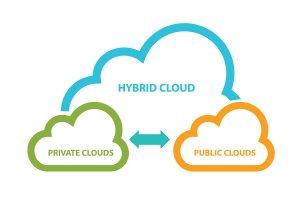
As cloud gains momentum as a platform for government IT, the one-size-fits-all solution is becoming obsolete. Government organizations require unique solutions to suit their specific needs, which is why understanding the cloud platform options is the first step to making the change to the cloud. Initially, there were public clouds hosted completely off government sites by a third party (like Google or Amazon Web Services). Then came private clouds, infrastructure and networks designed as a cloud but only available to a closed loop of individuals. Private clouds are hosted on-premise by the government entity they were built for. Now, there is a third type of cloud implementation that is proving to be the most popular and most attractive to government agencies - the hybrid cloud.
Hybrid infrastructures mean that some elements are hosted in a cloud (either public or private) while others are managed on-premise. There is a connection that allows all systems to work seamlessly. This set-up alleviates security concerns and helps organizations maintain tight control over critical applications.
Additionally, a hybrid environment helps avoid vendor lock-in. As agencies found with hardware, becoming an all "one vendor" shop has drawbacks. While going with a single IT vendor can have initial cost savings and economies of scale, in the long run, agencies grew frustrated when that one vendor could not innovate quick enough or provide the support they needed. Agencies are wary of falling into the same trap with cloud providers and look to spread out their applications across several platforms. This allows them to pick the cloud infrastructure that works best for that particular IT solution. There are hybrid cloud management tools that "abstract away many of the common features offered by different cloud providers" making it easier to manage multiple clouds. Continue reading



 Computing has moved from a fringe technology that agencies were willing to try to a mainstream part of IT strategy and infrastructure.
Computing has moved from a fringe technology that agencies were willing to try to a mainstream part of IT strategy and infrastructure.  The digitization of records and processes across government increases the need for sound digital investigation tools and processes. Whether it is looking into a data breach or gathering information for litigation, organizations are spending a lot of time culling through this data to get answers to pressing issues. An
The digitization of records and processes across government increases the need for sound digital investigation tools and processes. Whether it is looking into a data breach or gathering information for litigation, organizations are spending a lot of time culling through this data to get answers to pressing issues. An  We've written before about the importance of
We've written before about the importance of 
